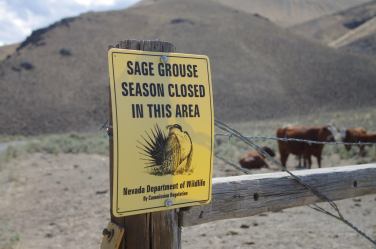
“If this is what the livestock industry and the state see as habitat preservation we can kiss the sage grouse good bye along with any remote pretense of management,” concluded Fite. (photo WildLands Defense)
Clandestine Grazing Agreement Draws More Legal Fire From Environmental Groups
(Battle Mountain, NV) This week documents were filed against the ongoing grazing agreement between the Bureau of Land Management (BLM) and livestock permittees of the “Argenta” allotments. This saga of intimidation, secrecy and rangeland degradation has spanned years and has been relegated, under agreement, to the National Riparian Services Team (NRST).
Members of WildLands Defense (WLD) and Wild Horse Education (WHE) cite multiple instances of agency failure to protect degraded habitat, while operating in apparent secrecy under intense political and physical intimidation by the livestock industry. A timeline of events can been seen here: http://bit.ly/1N8sCfI
The Argenta dispute over grazing restrictions due to drought was met with intense opposition from the livestock interests. A protest camp was erected on the heels of the “Bundy stand off.”
A “settlement” was reached that closed the doors to public access to engage any government process, as degradation of the rangeland continued. The meetings where monitoring, project and management decisions are continuing to be conducted behind “closed doors.”
WLD and WHE are non-profit organizations, and “Argenta Interested Publics.” Fite and Leigh have combined decades of experience in public lands grazing, interact with BLM staff on a routine basis, participate in site visits regularly regarding a broad range of public lands issues. In spite of federal requirements to include such individuals in process these organizations have been barred.
Documents filed in protest to WLD’s Appeal claim the documents are “too long.” “The biased actions have handicapped WLD’s participation and understanding of the environmental damage – and how grazing is taking place, controlled and monitored. This harms our ability to effectively distill information for our members, media, the public, and other groups – and to be able to participate in comment, protest, and Appeal processes on an equal footing,” stated WLD, in reply.
“When you are excluded from participation in process, yet witness absolute travesty on the ground, how are you supposed to remain informed to the agenda of the process?” said Leigh of WHE, “Exclusionary participation in public process is simply inefficient, ineffective and unlawful. No matter how you look at this the only conclusion is that someone does not want the public informed.”
The Settlement Agreement actually strips even basic measures to limit location of livestock to protect the range. “Because it is difficult to predict in advance where cattle will be in a location, on which days, how many, and for how long.” This contradicts any concept of managed livestock.
“In other words, there is no real control and plan, and the situation is chaotic.” said Fite of WLD, “I have seen destroyed monitoring cages and reference sites, cattle strung out all over the place, water sources turned into puddles filled with the smell of urine. I have been given no voice in process. It is an outrage.”
The National Riparian Services Team (NRST) is continuing to engage the settlement agreement between livestock permittees and the BLM. WLD and WHE state in documents that BLM managers have been “hamstrung” by the agreement from implementing any measure to immediately protect the environment from ongoing degradation.
The Attorney General of the State of Nevada and Nevada County Commissions have filed suit to stop sage grouse protections by the Department of Interior (DOI). The federal plan was implemented in lieu of listing the bird on the endangered species list. The suit claims that income to livestock producers will be harmed if they face “undue” restrictions. The suit claims the state can “do a better job” managing the sage grouse.
“If this is what the livestock industry and the state see as habitat preservation we can kiss the sage grouse good bye along with any remote pretense of management,” concluded Fite.
~~~~~
More Information:
Videos taken by Katie Fite of WildLands Defense. Katie has devoted her life to environmental protection and has documented these allotments for nearly two decades.
https://www.youtube.com/watch?v=Zj7w8w_ZWek&list=PLc5tAFyq8zIbJ4NK9SLxzAgCtLMXfv-Ty&index=14
Note for WHE supporters: We are very active in gaining accountability in all facets of public land management. We share information and photographs with multiple orgs including WLD. The ability of wild horses to exist on public land is tied to directly to preservation of habitat. “A dead range supports nothing.”
Click Image below to learn more.
Categories: Lead, Wild Horse Education

You must be logged in to post a comment.